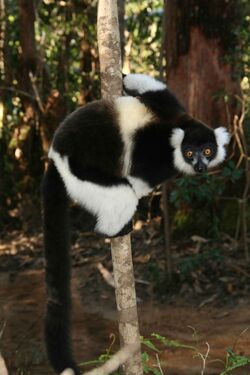Varecia variegata (Black-and-white Ruffed Lemur): Difference between revisions
imported>Kim van der Linde No edit summary |
imported>Kim van der Linde (→Status: double) |
||
| Line 37: | Line 37: | ||
The black and white ruffed lemur may be found in small areas of tropical moist lowland and montane forests of eastern Madagascar<ref name= "Mittermeier"/>. | The black and white ruffed lemur may be found in small areas of tropical moist lowland and montane forests of eastern Madagascar<ref name= "Mittermeier"/>. | ||
Revision as of 11:05, 13 September 2007
| Black-and-white Ruffed Lemur | ||||||||||||||
|---|---|---|---|---|---|---|---|---|---|---|---|---|---|---|
 A Black and white ruffed lemur, (Varecia variegata variegata).Template:Photo
| ||||||||||||||
| Conservation status | ||||||||||||||
| Scientific classification | ||||||||||||||
| ||||||||||||||
| Binomial name | ||||||||||||||
| Varecia variegata (Kerr, 1792) |
The Black and white ruffed lemur Varecia variegata variegata is a large quadrupedal Lemur. In the wild, it is found only on the island of Madagascar.
Description
The Black and white ruffed lemur is a diurnal Primate that has a head body length of approximately 43 – 57 cm and a tail length of around 60-65 cm[2][3][4]. Weight ranges between approximately 3 and 3.5 kg[4]. Coat color, as the common name suggests, is black and white. [4]. The coat and tail are fluffy and the black and white ruffed lemur has prominent "tuffs" on the ears[4]. There are no size or color differences that distinguish males from females.
Behaviour
Studies show significant variation in group size and territorial behaviour [3][4]. The black and white ruffed lemur moves mostly quadrupedally but is also an adept leaper[4]. It has been noted that this species is possibly the only Primate to build nests exclusively for the birth of young[4].
Diet
It is highly frugiverous but also eats seeds, leaves and nectar [3][4].
Geographical distribution
The black and white ruffed lemur may be found in small areas of tropical moist lowland and montane forests of eastern Madagascar[4].
References
- ↑ Baillie (1996). Varecia variegata. 2006 IUCN Red List of Threatened Species. IUCN 2006. Retrieved on 11 May 2006. Listed as Endangered (EN A1cd v2.3)
- ↑ J. Fleagle (1998). Primate Adaptation and Evolution. Academic Press: New York.
- ↑ 3.0 3.1 3.2 F. Szalay and E. Delson (2001). Evolutionary History of the Primates. Academic Press, New York.
- ↑ 4.0 4.1 4.2 4.3 4.4 4.5 4.6 4.7 4.8 4.9 Mittermeier et al. (2006). Lemurs of Madagascar. Conservation International.

